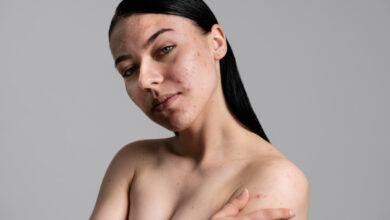
Makeup is a fantastic tool for bringing out our inner creativity and enhancing our attractiveness. But not every makeup item works well with every other one. Certain combinations may result in unintended reactions or reduce the products’ efficacy. Here’s a list of makeup products you should never use together to help you apply makeup flawlessly and prevent accidents.
Water- and oil-based products
Combining makeup products with different bases—oil and water—can create a streaky or patchy appearance.
Since oil and water don’t mix well, using an oil-based foundation over a water-based primer, for example, can cause the products to separate on the skin. Keep your makeup routine limited to water- or oil-based products for flawless application.
Moreover, combining cosmetic products with different bases—oil and water—can impact how long your makeup lasts.
Water and oil repel one another. Thus, cosmetics may not stick to the skin as intended, causing makeup to wear off or fade quickly during the day.
If you need your makeup to stay on all day or are attending an event, this can be troublesome.
By sticking to products with similar bases, you can ensure that your makeup stays in place and looks fresh for hours without touching it up often.
Products Based on Silicone and Water
Like oil- and water-based products, silicone-based and water-based products may only sometimes work well together.
Water-based products hydrate, and silicone-based primers and foundations produce a smooth, pore-minimizing base.
Combining the two may result in the makeup on the skin balling up or piling up. Choose products with comparable bases to prevent this and complement one another well.
Furthermore, combining water- and silicone-based products might not allow them to blend perfectly, giving the skin a rough or uneven look.
Water-based foundations offer light coverage and hydration, while silicone-based primers fill in pores and fine wrinkles to produce a smooth canvas.
When combined, these two formulas may reject one another, resulting in an uneven makeup application on the skin’s surface.
Using products with bases complementing one another’s textures and qualities can help you create a beautiful finish.
This guarantees that your makeup application is flawless, long-lasting, and free from undesired clumping or pilling.
Cream and Powder Items
Because cream and powder products have distinct consistencies and textures, it can be challenging to layer them on top of one another.
For example, using cream blush or highlighter over a powdered foundation might make the makeup look uneven or cakey.
To avoid this, apply cream products first, then set with powder, or use all-cream or all-powder formulations for a smooth finish.
Oil-and Waterproof-Based Products
Waterproof makeup is long-lasting and smudge-proof because it resists perspiration, humidity, and tears. However, waterproof makeup removers or oil moisturizers might degrade the makeup and make it spread or smear.
Choose a mild, oil-free makeup remover if you wear waterproof eyeliner or mascara to guarantee removal that doesn’t shorten the products’ lifespan.
Retinol and Exfoliating Products
Vital elements that enhance skin tone and texture include exfoliating acids and skincare products containing retinol.
On the other hand, combining them can make irritation, redness, and sensitivity more likely.
To reduce the possibility of adverse reactions, it is advisable to incorporate exfoliating and retinol treatments into distinct parts of your skincare routine. For example, retinol products can be used at night, and acids can be exfoliated in the evening.
Products Including Vitamin C and Retinol
Potent antioxidants like vitamin C brighten skin and shield it from the elements, while retinol increases the creation of collagen and smoothes out the skin’s structure.
Even if each ingredient has several advantages, using them in the same skincare routine can lessen their effectiveness and irritate the skin.
Use retinol products in the evening and vitamin C products in the morning to ensure that each ingredient works appropriately without interfering with the other and to get the full advantages of both.
Exfoliating Products and Acne Treatments
When treating skin prone to breakouts, it’s crucial to refrain from mixing harsh acne treatments with exfoliating products like scrubs or chemical exfoliants.
Excessive exfoliation can damage the skin’s moisture barrier and remove natural oils, which can cause irritation, dryness, and inflammation.
Instead, to maintain balanced, healthy skin, use acne treatments sparingly and include moderate exfoliation in your routine no more than twice or thrice a week.
Thick Bases and Brightening Primer
Illuminating primers give the skin luminosity and glow; heavy, full-coverage foundations are meant to provide a perfect, matte finish.
A dull, flat complexion might arise from using a heavy foundation over an illuminating primer, which will reduce the primer’s luminosity.
Choose a lightweight foundation or tinted moisturizer that goes well with the illuminating primer if you like a radiant finish to get a natural glow.
Lip glosses and matte lipsticks
Matte lipsticks are renowned for their durable, transfer-proof composition, while lip glosses offer a glossy, sparkling appearance.
Layering a matte lipstick with a lip gloss may shorten its lifespan, which can accelerate the lipstick’s fading and breakdown.
To enhance the look of a matte lipstick without preserving its integrity, try using a translucent lip gloss or lip balm in a hue that matches the matte lipstick.
Creme Foundations and Powder Highlighters
Powder highlighters can make the skin look more radiant, while cream foundations provide a natural finish and buildable coverage.
However, using a powder highlighter over a cream foundation can make the highlight look patchy or cakey since the cream foundation does not give the powder a smooth surface to stick to.
Depending on the texture you want, use all cream or all powder products in your makeup routine to get a soft, blended look.
Final Thoughts!
In cosmetics, compatibility, and balance are necessary to get perfect results. You may minimize adverse reactions, guarantee peak performance, and extend the wear time of your makeup by knowing which cosmetics not to mix and match.
Whether you’re new to makeup or a beauty connoisseur, these tips will help you make sense of the wide range of makeup products on the market and create gorgeous looks with ease and confidence.



